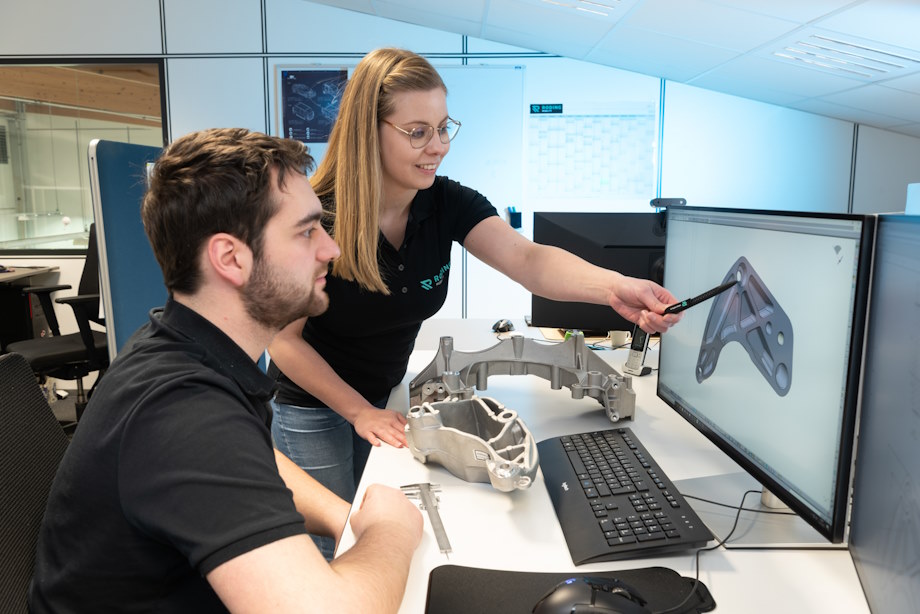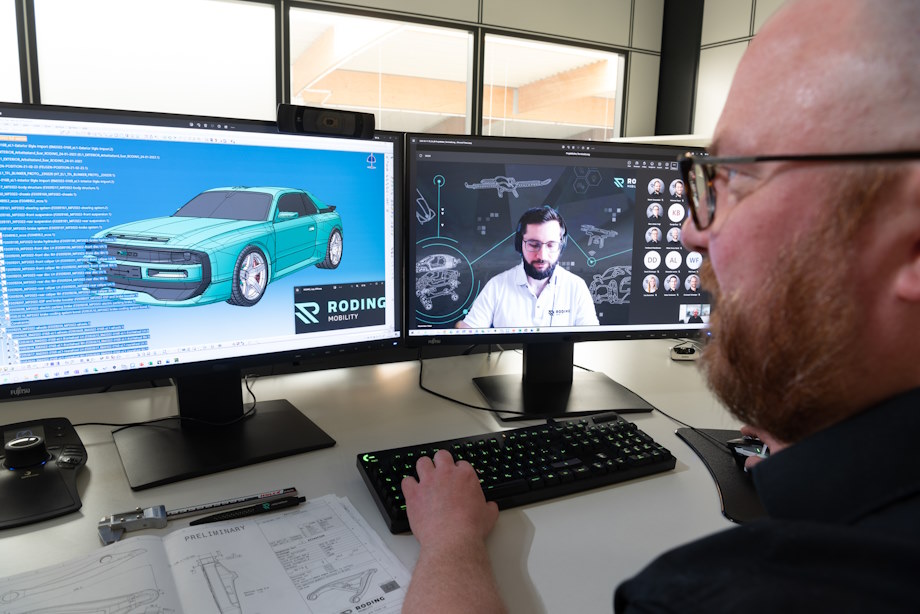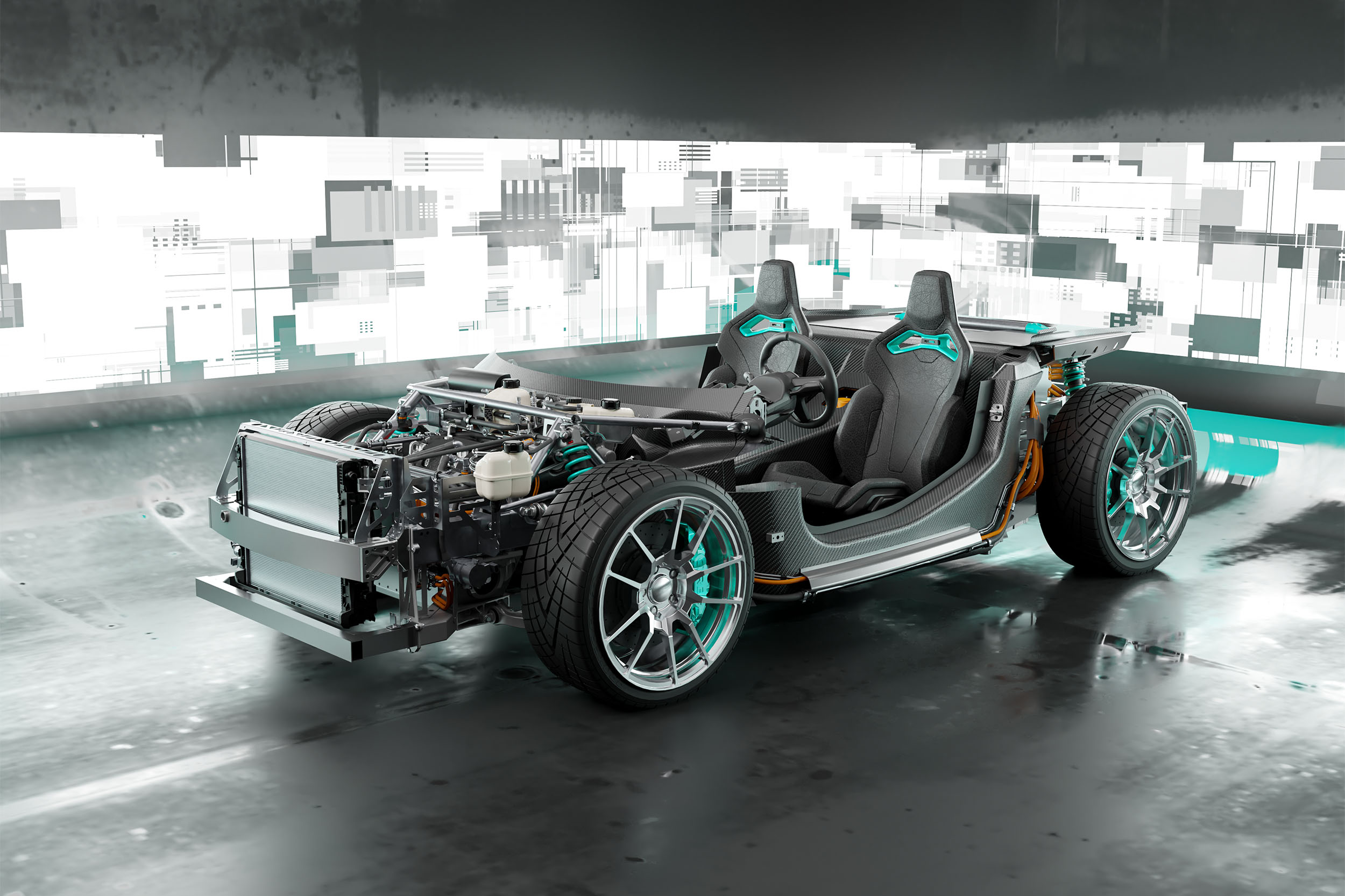Roding Mobility
German engineering company Roding Mobility specialises in composite materials and high performance electrical systems and uses the 3DEXPERIENCE platform to manage its increasingly complex products and processes. The implementation of the On Target Vehicle Launch industry solution for design and engineering helps to eliminate unnecessary loops, reduce physical prototypes and cut assembly time by 30%.
Delivering electric mobility concepts at speed
Reaching 100 kilometers (62 miles) per hour in just 3.9 seconds, the Roding Roadster exemplifies what’s possible when you combine cutting-edge engineering capabilities with the latest advances in carbon fiber technology. Weighing just 950kg, the lightweight sportscar was the vision of two engineers, Günther Riedl and Ferdinand Heindlmeier, who harnessed their technical and entrepreneurial capabilities to found Roding Mobility, develop their roadster concept from scratch and manufacture it in small series. Fast forward to today and that experience and innovative spirit lives on in Roding’s 80-strong multidisciplinary team – a company renowned for its ability to manage diverse and highly complex mobility projects, from street-legal prototypes and full electric vehicles to state-of-the-art powertrain and battery systems, all delivered in the fastest possible time.
Speed is what stands Roding Mobility apart from the rest. Whether the company is developing electric vehicle concepts or modular battery systems for the next generation of passenger vessels, its completely holistic engineering approach allows it to progress seamlessly from one stage to the next.
“As one of the fastest one-stop-shops for mobility solutions worldwide, our daily business is to bring to life functional prototypes and subsystems of future electric mobility concepts as quickly as possible,” said Günther Riedl, co-founder and CEO of Roding Mobility. “We keep in mind engineering and manufacturing, but also the downstream use of the product across its full lifecycle.”
More recently, Roding has turned its attention to its digital strategy – and specifically how it can use the product lifecycle management (PLM) and virtual twin capabilities on the 3DEXPERIENCE platform – to continually speed up product development without compromising on quality.
“Our dedication to virtual twins within the 3DEXPERIENCE platform has revolutionized our approach to product development and lifecycle management, providing us with a powerful toolset for virtual prototyping, real-time monitoring and predictive analytics,” Riedl said. “By harnessing these capabilities, we can enhance product quality and reliability, and reduce the number of hardware loops, which directly contributes to a more sustainable engineering and development process.”
Our dedication to virtual twins within the 3DEXPERIENCE platform has revolutionized our approach to product development and lifecycle management, providing us with a powerful toolset for virtual prototyping, real-time monitoring and predictive analytics.
Supporting collaborative engineering
Before moving to the 3DEXPERIENCE platform, Roding managed its design data in a file-based system, which presented significant challenges in terms of data organization, version control, collaboration, security and scalability.
“These challenges increased the risks of failing timelines as well as manufacturing issues such as installing wrong parts that would not fit the final product,” said Max Faber, head of engineering at Roding Mobility.
Roding’s technology partner TECHNIA reviewed the company’s internal processes and suggested that the 3DEXPERIENCE platform would be a good fit, particularly for supporting collaborative engineering. Moving all design and engineering processes to a centralized platform would give every stakeholder access to live data and the most up-to-date status of a project.
“TECHNIA and Dassault Systèmes offered us a solution which could grow with us – the 3DEXPERIENCE platform delivered all the upfront benefits we needed from PLM system with minimal administration requirements, and has the scalability to fit our future needs,” Riedl said. “TECHNIA understands us and invested a lot into prechecks on sample assemblies. This is very similar to how we work with our customers. The team there is outstanding. We really value the synergies we have in terms of our philosophy and customer service.”
Today, the 3DEXPERIENCE platform facilitates engineers, designers, purchasers and other stakeholders to work together more effectively, regardless of their role on each project. Everyone can securely access the information they need to do their job.
“The biggest impact of the 3DEXPERIENCE platform and our partnership with Dassault Systèmes has been the transformation of our product development and engineering processes,” Faber said. “System engineers can see parts and systems in context of the wider product, eliminating silos and fostering cross-functional teamwork. We no longer need as many synchronization meetings, which reduces overall product development timelines while raising quality.”
This centralized approach is boosting productivity and supporting modern, flexible ways of working. Roding’s engineers value the ability to work remotely – saving on time commuting to the office and reducing their carbon footprint in the process.
“It used to be mandatory for engineers to be onsite in the factory to access the huge CAD structures and avoid long loading times,” Riedl said. “Now, with the 3DEXPERIENCE platform, it doesn’t matter where our team members are located. Our remote working rate is higher and, as a company, we produce significantly fewer carbon emissions caused by commuting.”

Company gains centralized view of all parts
Roding uses CATIA on the 3DEXPERIENCE platform to design and engineer all mechanical and composite components and structures. Among the many features it takes advantage of is Composite Designer, which supports it to create ply models, test for manufacturing feasibility and generate all related manufacturing documentation including ply books and flat patterns. The company also uses the solution to explore the viability of more sustainable and renewable fibers and resins.
“Having all this functionality within the same system is a massive advantage as we can implement geometry updates a lot easier,” Faber said. “It’s a lot of fun to design parts and surfaces such as sheet metal parts or solids. We have some power users who are really focused on trying new things out to take full advantage of the software and make our workflows even more efficient.”
The types of vehicles and systems Roding builds today are more complex than ever and involve the integration of thousands of different components. The 3DEXPERIENCE platform is proving invaluable for keeping track of everything and supporting engineers to develop these highly sophisticated products.
“Our on premise 3DEXPERIENCE platform hosts more than 100,000 individual parts, taking up around two terabytes of space,” Riedl said. “A typical vehicle has around 10,000 parts, consisting of roughly 3,000 different individual parts, half of which are individually designed by us and the rest from suppliers. One of the biggest benefits was to make supplier parts available to the whole team and reduce time looking for similar products.”
The biggest impact of the 3DEXPERIENCE platform and our partnership with Dassault Systèmes has been the transformation of our product development and engineering processes.
Virtual twins underpin manufacturing quality
Roding’s current focus is to develop an accurate virtual twin of all parts and products, such as an entire electric vehicle, on the 3DEXPERIENCE platform. This precise digital replica will help the company reach the final manufacturing stage faster and produce fewer physical prototypes in the process.
“We are 100% dedicated to the virtual twin approach and we now prioritize refining the virtual twin rather than rushing to build a rough physical model,” Riedl said. “We’re even putting cable ties into our CAD models to make sure they reflect exactly how they will be in the real world.”
The virtual twin not only helps to guarantee fit, form and function but automatically supports processes like bill of materials (BOM) management. Engineers can readily access 3D models and export the engineering BOM with all corresponding part numbers. Roding plans to extend its use of the virtual twin down to the shop floor, so that mechanics can look at the virtual twin to review the full vehicle, understand the surrounding system during the vehicle build, and quickly flag any potential issues ahead of time.
“By integrating more parts into the virtual twin, we can manage growing complexity, boost overall quality and shorten the timeline between finalizing our designs and manufacturing the final product,” Faber said. “It used to take roughly six to eight months to assemble a vehicle. The virtual twin approach helps us to reduce the assembly time by around 30%.”

Closer customer relationships
Looking ahead, Roding is open to the possibility of using the cloud-based version of the 3DEXPERIENCE platform to take advantage of its secure, remote access capabilities so it can communicate with customers in a seamless and convenient manner. It also hopes to use the virtual twin to foster closer customer collaboration. By designing, testing and refining everything in the virtual world first, the company can build a greater level of trust and credibility in its engineering capabilities and the performance of its products well ahead of them being manufactured.
“Our plan is to collaborate directly with our customers and partners on the 3DEXPERIENCE platform,” Riedl said. “Via the virtual twin, customers will be able to visualize and review final designs, make comments, and confirm and release designs jointly, in real time, with our program managers and engineers. Our digital transformation strategy is instrumental in shaping the future of Roding Mobility.”
Discover more about the On-Target Vehicle Launch industry solution experience.

Focus on Roding Mobility
Roding Mobility is an internationally active, future-oriented technology service provider and system supplier. Based in Germany, the company develops, designs and manufactures individual components and complete systems for the mobility concepts of tomorrow. As a one-stop shop, it offers its customers innovative solutions ranging from simple CFRP optical components and complex fiber composite assemblies to the development and production of high-voltage battery storage systems and complete street-legal vehicles.
For more information: https://roding-mobility.de/en/

Focus on Technia
TECHNIA is the leading global Dassault Systèmes partner, providing unrivaled customer value with our unique combination of partner solutions, in-house software, and expert skills.
We provide complementary software, services, training, and support for the complete Dassault Systèmes portfolio of products: 3DEXPERIENCE, BIOVIA, CATIA, DELMIA, DYMOLA, ENOVIA, NETVIBES, SIMULIA, SOLIDWORKS, and more.
We actively seek out clients whose leading-edge technologies provide creative solutions to the world’s most pressing concerns. We build long-lasting relationships with ambitious customers who trust that we’re big enough to deliver yet small enough to care.
Together, we make sure innovation has the best conditions to thrive, so that our customers can bring smarter products to market faster.
For more information: https://technia.com


